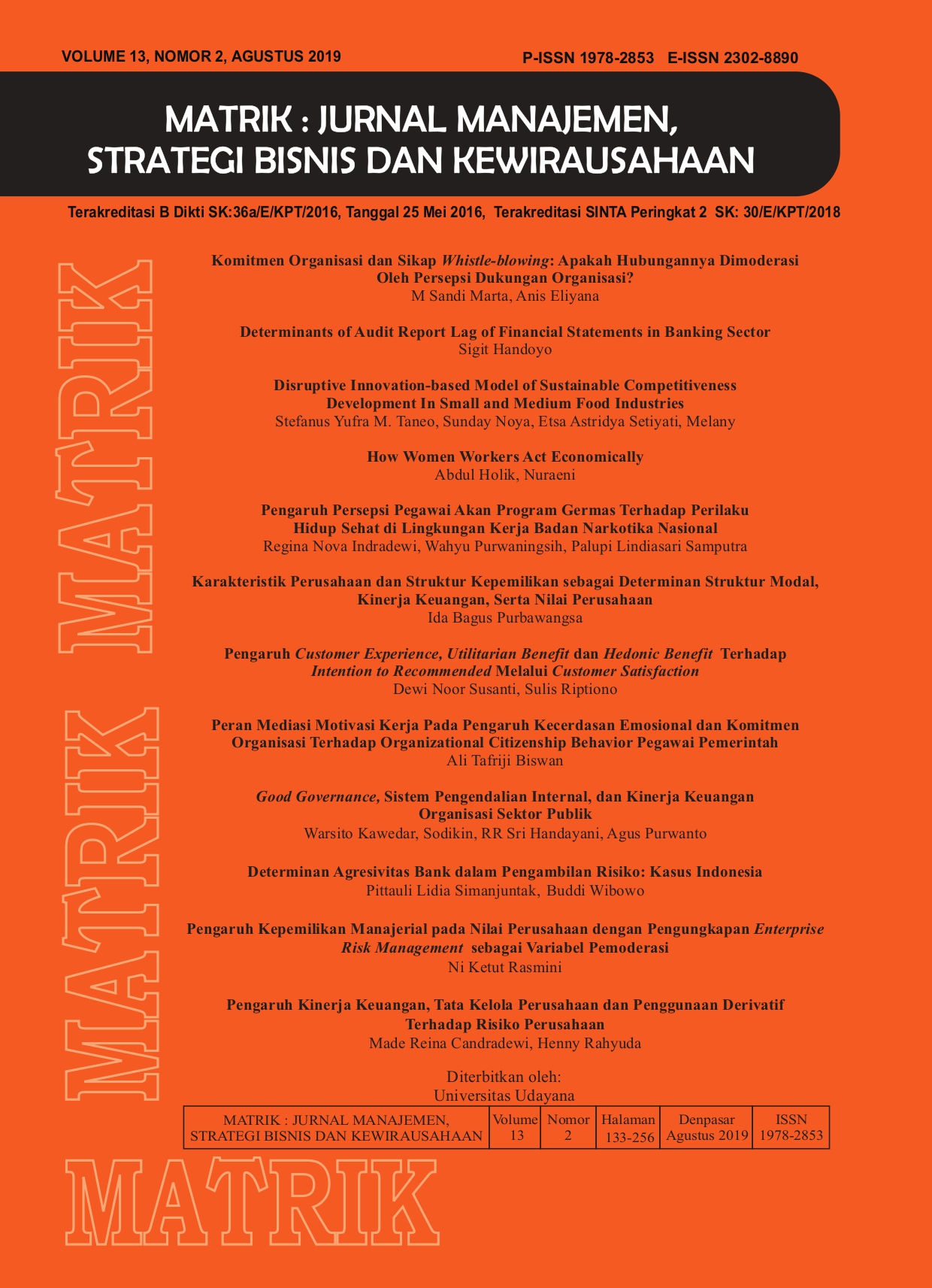Pengaruh Customer Experience, Utilitarian Benefit dan Hedonic Benefit terhadap Intention to Recommended melalui Customer Satisfaction
Abstract
Abstrak
Pengalaman konsumen dan desain suatu produk merupakan salah satu unsur yang penting dalam pemasaran, manfaat desain diharapkan mampu membuat konsumen merasa puas. Apakah pengalaman konsumen dan design benefit selalu dapat meingkatkan kepuasan konsumen? Penelitian ini bertujuan untuk menguji pengaruh customer experience dan design benefit (utilitarian benefit dan hedonic benefit) terhadap intention to recommended dengan kepuasan konsumen sebagai variabel interviening. Penelitian yang dilakukan dengan dengan melibatkan 100 responden yang menggunakan produk smartphone iPhone di Kabupaten Kebumen, diambil dengan menggunakan tehnik purposive sampling. Data yang terkumpul kemudian dianalisis dengan menggunakan path analyze dan diolah dengan bantuan alat statistic SPSS 24.0. Hasil penelitian menunjukkan bahwa dari ketujuh hipotesis hanya ada satu yang ditolak yaitu hipotesis kelima. Temuan penelitian ini mengungkapkan bahwa variabel customer experience dan hedonic benefit merupakan anteseden dari kepuasan konsumen yang dapat menumbuhkan intention to recommended, sedangkan pada variabel utilitarian benefit hanya dapat berpengaruh terhadap kepuasan konsumen tetapi tidak dapat menumbuhkan intention to recommended konsumen.
Downloads
References
Abdurrahman, Maman., Simbas Ali Muhidin dan Ating Somantri. 2011. Dasar-Dasar Metodologi Statistik untuk penelitian. Bandung: Pusaka Setia.
Ali, Faizan., Woo Gon Kim, Jun Li & Hyeon-Mo Jeon. 2016. Make it Delightful: Customers' Experience, Satisfaction and Loyalty in Malaysian Theme Parks. Journal of Destination Marketing & Management. http://dx.doi.org/10.1016/j.jdmm.2016.05.003.
Altunel, M. C., & Erkut, B. 2015. Cultural Tourism in Istanbul: The Mediation Effect of Tourist Experience and Satisfaction on the Relationship Between Involvement and Recommendation Intention. Journal of Destination Marketing & Management, Vol. 4, 213–221.
Ampuero, O., & Vila, N. 2006. Consumer Perceptions of Product Packaging. Journal of Consumer Marketing, Vol. 23, 100–112.
Anselmsson, J., Johansson, U., & Persson, N. 2007. Understanding Price Premium for Grocery Products: A Conceptual Model of Customer-Based Brand Equity. Journal of Product and Brand Management, 16, 401–414.
Carpenter, J. M., & Fairhurst, A. 2005. Consumer Shopping Value, Satisfaction, and Loyalty for Retail Apparel Brands. Journal of Fashion Marketing and Management, 9, 256–269.
Chitturi, Ravindra, Rajagopal Raghunathan, and Vijay Mahajan. 2007. Form Versus Function: How the Intensities of Specific Emotions Evoked in Functional Versus Hedonic Trade-Offs Mediate Product Preferences. Journal of Marketing Research, Vol. 44, 702–714.
Chitturi, Ravindra., Rajagopal Raghunathan, & Vijay Mahajan. 2008. Delight by Design: The Role of Hedonic Versus Utilitarian Benefits. Journal of Marketing, Vol. 72, pp. 48–63.
Chen, T. Y., Chang, P. L., & Chang, H. S. 2005. Price, Brand Cues, and Banking Customer Value. International Journal of Bank Marketing, Vol. 23, 273–291.
de Matos, C.A. and C.A.V. Rossi. 2008. Word-of-mouth Communications in Marketing: A Meta-Analytic Review of the Antecedents and Moderators. Journal of the Academy of Marketing Science, Vol. 36(4): p. 578-596.
Fischer, A. R. H., & Frewer, L. J. 2009. Consumer Familiarity with Foods and the Perception of Risks and Benefits. Food Quality and Preference, Vol. 20, 576–585.
Ghozali, Imam. 2011. Aplikasi Analisis Multivariate Dengan Program SPSS. Edisi II. Badan Penerbit: Universitas Diponegoro. Semarang.
Hair, J. R.., Anderson, R. E., Tatham, R. L., & Black, W. C. 1998. Multivariate Data Analysis (5th ed.). Upper Saddle River, NJ: Prentice Hall.
Jang, N., Dickerson, K. G., & Hawley, J. M. 2005. Apparel Product Development: Measures of Apparel Product Success and Failure. Journal of Fashion Marketing and Management, Vol. 9, 195–206.
Kim, W. G., Li, J. J., & Brymer, R. A. 2016. The Impact of Social Media Reviews on Restaurant Performance: The Moderating role of excellence award. International Journal of Hospitality Management, 55(5), 41–51.
Krystallis, A., & Ness, M. 2003. Motivational and Cognitive Structures of Greek Consumers in the Purchase of Quality Food Products. Journal of International Consumer Marketing, 16 (2), 7–36.
Li, J. J., Kim, W. G., & Wong, I. A. 2016. Does Destination Perception Differ Based on Traveler Type? A case of ‘Las Vegas of Asia’. Tourism Planning & Development. http://dx.doi.org/10.1080/21568316.2016.1152289.
Löfgren, M. 2008. Customer Satisfaction in the First and Second Moments of Truth. Journal of Product and Brand Management, 17, 463–474.
Löfgren, M., & Witell, L. 2005. Kano’s Theory of Attractive Quality and Packaging. Quality Management Journal, 12(3), 7–30.
Meyer, C., & Schwager, A. 2007. Understanding Customer Experience. Harvard Business Review, 85(2), 117–126.
Na, W., Son, Y., & Marshall, R. 2007. Why Buy Second-Best? The Behavioral Dynamics of Market Leadership. Journal of Product and Brand Management, 16, 16–22.
Oliver, R. L. 1997. Satisfaction: A Behavioral Perspective on the Consumer. New York: McGraw-Hill.
Orth, U. R., Campana, D., & Malkewitz, K. 2010. Formation of Consumer Price Expectation Based on Package Design: Attractive and Quality Routes. Journal of Marketing Theory and Practice, 18, 23–40.
Prayag, Girish., Sameer Hosany, Birgit Muskat and Giacomo Del Chiappa. 2017. Understanding the Relationships Between Tourists’ Emotional Experiences, Perceived Overall Image, Satisfaction, and Intention to Recommend. Journal of Travel Research, Vol. 56(1) 41 –54.
Rundh, B. 2009. Packaging Design: Creating Competitive Advantage with Product packaging. British Food Journal, 111, 988–1002.
Silayoi, P., & Speece, M. 2007. The Importance of Packaging Attributes: A Conjoint Analysis Approach. European Journal of Marketing, 41, 1495–1517.
Schmitt, B.H. 2010. Customer Experience Management: A Revolutionary Approach to Connecting with Your Customers, John Wiley & Sons.
Smith, R. E., & Wright, W. F. 2004. Determinants of Customer Loyalty and Financial Performance. Journal of Management Accounting Research, 16, 183–205.
Sugiyono. 2010. Metodologi Penelitian Bisnis: Pendekatan Kuantitatif, Kualitatif, dan R&D. Bandung: Alfabeta.
Tjiptono, Fandy. 2011. Pemasaran Jasa. Malang: Penerbit Bayumedia.
Underwood, R. L. 2003. The Communicative Power of Product Packaging: Creating Brand Identity Via Lived and Mediated Experience. Journal of Marketing Theory and Practice, 11, 62–76.
Wang, Edward Shih-Tse. 2017. Different Effects of Utilitarian and Hedonic Benefits of Retail Food Packaging on Perceived Product Quality and Purchase Intention. Journal of Food Products Marketing, 23:3, 239-250, DOI: 10.1080/10454446.2014.885867.
Westbrook, R., & Oliver, R. 1991. The Dimensionality of Consumption Emotion Patterns and Consumer Satisfaction. Journal of Consumer Research, 18(1), 84–91.
Xu, Chenyan., Daniel Peak & Victor Prybutok. 2015. A Customer Value, Satisfaction, and Loyalty Perspective of Mobile Application Recommendations, Decision Support Systems. Doi: 10.1016/j.dss.2015.08.008.
 This work is licensed under a Creative Commons Attribution-ShareAlike 4.0 International License.
This work is licensed under a Creative Commons Attribution-ShareAlike 4.0 International License.

















